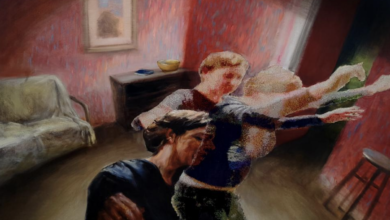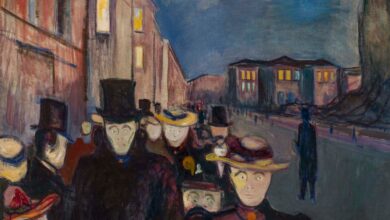Grayson Perry on popularity, pottery and class: ‘I still enjoy looking for discomfort in the faces of the overeducated’

Grayson Perry has just hung the biggest exhibition of his career, and it’s brought on an epiphany. “I’ve come to realise I’m a very old-fashioned artist,” says the irrepressible Turner Prize-winning potter, relaxing in his London studio. His concerns, he tells me, were “do the colours go together, are the compositions working, is it a nice texture” – basically, “what looks good together”.
That might seem a surprising pronouncement from someone who is widely regarded as having changed our perceptions of what an artist can be. Since coming virtually from nowhere to win the 2003 Turner Prize – notoriously wearing a dress to accept Britain’s biggest art award – Perry has been hyper-visible across an extraordinary range of platforms. He’s traversed Britain in TV series challenging our ideas about art and taste. He’s published books detailing his harrowing childhood and redemption through therapy. He’s done stand-up comedy, newspaper columns, and a new musical about his life, for which he’s written the lyrics. Oh, and back in June he was knighted by Prince William, with Perry again, of course, wearing a dress and full make-up.
Yet it’s clear talking to him that – unlike, say, Andy Warhol or Tracey Emin – he doesn’t regard everything he does as art. “Those other activities are just me having a go at things. I take them on without any prior skill. I’ve learnt on the job with everything I’ve done, including pottery. And I really enjoy doing all these things, but I don’t consider them part of my visual art.”
And those “other activities” haven’t prevented him from making the work to fill Edinburgh’s vast National Galleries of Scotland (Royal Scottish Academy) for his new career-spanning show. Wryly titled Smash Hits, the retrospective covers the full gamut of 40 years of his work, from the quirky pots that made his name to picture maps of British class and neon-frenetic tapestries inspired by Hogarth. “It’s just the most colourful exhibition,” he says with delight. That focus on how it looks – what looks good together – is clearly one he’s relished. It’s a consideration that he believes “a lot of artists today forget”.
“There’s a lot of emphasis on issues.” He says the word almost with distaste. “People forget that it’s got to look nice, that we go to galleries for fun. We go to galleries on our days off. We don’t go to get homework.”
Yet Perry has hardly harmed his career by dealing with issues, including identity, gender, class, taste and religion, to name just a few of those listed in his show’s catalogue.
“That’s true. But there’s a lot of art around today that has the dour veneer of seriousness, but is actually just a bit s***,” he says bluntly.
Success hasn’t dented Perry’s readiness to take a swing at whatever gets his goat. And at a time when even modestly successful artists surround themselves with protective networks of dealers, assistants and studio managers, Perry – arguably Britain’s most famous and popular artist – seems startlingly open and available. He answers the door to his studio himself, makes the coffee – “It’s instant, is that OK?” – and within moments we’re chatting away as though we’ve known each other for years. The studio is a surprisingly small, garage-like space, and Perry’s manner of dress is by his standards modest: pink T-shirt and brilliantly coloured dungarees. (The pattern proves on close inspection to depict female genitalia rather than flowers as I initially thought, but what do you expect?)
“There’s a lot of art around that feels like student work,” he says. “Like it hasn’t occurred to the artist that anyone else might have thought that climate change is a bad thing.”
With cancel culture making us all ever more desperate not to offend, Perry’s frankness is refreshing, whether he’s dismissing “upper middle intellectuals who are dead from the neck downwards” or young climate-conscious artists who are already “behind the times, mate”.
But his Edinburgh show, which opened on 22 July, is clearly the thing most on his mind today. “What I’d really like to do,” he says in a tone almost of wonder, “is to go round it with someone who doesn’t know me or my work, but is receptive to art. Just to see what they make of it.”
Which takes me back to my first sighting of Perry’s work at the 2003 Turner Prize exhibition. He was the outsider among the four contenders, with the Chapman Brothers firm favourites, and completely unknown to me. But peering at the ornate surface of one of his mock-grandiose vases, I caught sight of a sulky teenage girl’s face with the words, “F*** off you middle-class tourist”. I was instantly a fan. Perry lets out a ringing, almost satanic cackle at this recollection – a classic Perry laugh, and one of numerous that punctuate our conversation. “I’m glad you had that experience. That’s exactly the reaction I would like.”
His work’s mixture of self-mocking craftsmanship – he denies to this day that he’s a good potter – and edgy humour clearly spoke to many. Within 48 hours of my first sighting of his work, Perry had accepted Britain’s best-known art prize as his female alter ego Claire, with the classic headline-grabbing utterance “What the art world needs is a transvestite potter” – and had instantly become a national figure. Over the subsequent 20 years, he’s made himself so ubiquitous across so many areas of British life that I feel I can hardly get to the thing that is supposedly his raison d’etre: his art.
“Yeah, all those things do affect my art, I’m sure. I’m well organised. I make sure there’s plenty of time for the work I need to produce. But popularity is something I’ve flirted with for years, precisely because it’s so frowned upon by the po-faced contemporary art establishment. And I’m talking about genuine popularity rather than, ‘Oh look, here’s a theme park ride we can all go on!’”
Theme park rides? Who could he mean?
Sir Grayson Perry, Sacred Tribal Artefact, 2023, Tapestry, 200 x 350 cm 78 3/4 x 137 3/4 inches
“I remember watching people going on Carsten Holler’s slides” – the German artist’s stainless steel slides exhibited at Tate Modern to great excitement in 2006 – “and thinking, ‘They’re enjoying that, but do they think it’s good art?’”
Perry clearly thought it wasn’t. But does he now feel genuinely popular himself?
“Yeah,” he shrugs, with a “why wouldn’t I” nonchalance. And despite two decades of hyper-visibility, he has never faced a backlash. The idea that a transvestite is best placed to lecture British men on masculinity and the need to show vulnerability hasn’t become annoying. There have been grumbles from snooty critics – who, me? – but neither the British public, nor the media, nor the so-called art world have quite got fed up with Grayson Perry.
“Well, we’ll see,” he says. “I’ve been waiting 20 years for it to happen. Anyone who gets at all popular in Britain has to be aware that there are plenty of people who will relish seeing them fall.”
Anyone who gets at all popular in Britain has to be aware that there are plenty of people who will relish seeing them fall
Grayson Perry: ‘We go to galleries on our days off. We don’t go to get homework’





